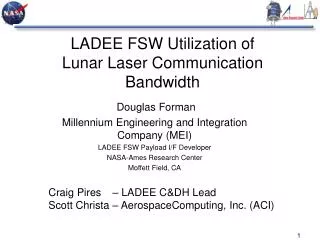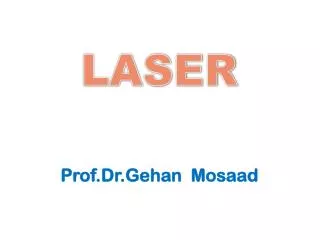Laser Communication
Laser Communication. Presented by, P.Anitha(08MCS204). Introduction . Laser communications systems are wireless connections through the atmosphere. Use Laser Beams to transmit information between two locations No fibres need, a wireless technology
Share Presentation
Embed Code
Link
Download Presentation
- telescope
- pulse rate
- direct detection techniques
- atp gospi03b
- spectral irradiance
- laser communication

holli + Follow
Download Presentation
Laser Communication
An Image/Link below is provided (as is) to download presentation Download Policy: Content on the Website is provided to you AS IS for your information and personal use and may not be sold / licensed / shared on other websites without getting consent from its author. Content is provided to you AS IS for your information and personal use only. Download presentation by click this link. While downloading, if for some reason you are not able to download a presentation, the publisher may have deleted the file from their server. During download, if you can't get a presentation, the file might be deleted by the publisher.
Presentation Transcript
- Laser Communication Presented by, P.Anitha(08MCS204)
- Introduction • Laser communications systems are wireless connections through the atmosphere. • Use Laser Beams to transmit information between two locations • No fibres need, a wireless technology • Communication over long distances, e.g. between planets • Laser Communication Terminals (LCTs) transmit a laser beam and are capable of receiving laser beams Technical Seminar-II
- How does it Work Signal Transmitter Laser Receiver Signal Technical Seminar-II
- Laser Transmitter and Receiver Technical Seminar-II
- A one-way Laser communication system. Technical Seminar-II
- Laser Transmitter • The transmitter involves: • Signal processing electronics(analog/digital) • Laser modulator • Laser( Visible, near visible wavelengths) Technical Seminar-II
- Modulation • AM • Easy with gas lasers,hard with diodes • PWM • PFM • Potentially the highest bandwidth(>100kHz) Technical Seminar-II
- Receiver • The receiver involves: • Telescope(‘antenna’) • Signal processor • Detector • PIN diodes • Avalanche Photo Diodes(APD) • Single or multiple detectors Technical Seminar-II
- Gain Systems • Transmitter • Maximum output power • Minimum divergence • Receiver • Maximum lens area • Clarity • Tight focus on detector Technical Seminar-II
- Laser Diode • Laser Diodes include Photodiodes for feedback to insure consistent output Technical Seminar-II
- Filters • Sun shade over detector • Shade in front of lens • Detector spectral response • Colored filters • Absorb ~50% of available light • Difficult to find exact frequency Technical Seminar-II
- Mounting Systems • Mounts and stands need only be as accurate as beam divergence • Good laser diodes will be 1-2mR (milliRadian) • A 32 pitch screw at the end of a 2' mount will yield 1mR per revolution. Since quarter turns (even eighth turns) are possible, this is more than accurate enough • Higher thread pitches allow shorter mounts which may be more stable (against wind, vibration, wires) • 1mR is 1.5 of divergence every 1000, 2000 etc. Technical Seminar-II
- Security Aspects • Free space laser communications systems have narrow optical beam paths, which are not accessible unless viewing directly into the transmitter path. • Any potential eavesdropping will result in an inter-ruption of the data transmission. • The existence of laser beams cannot be detected with spectrum ana-lyzers. Technical Seminar-II
- Safety Aspects • The free space laser communications systems do not require certification for handling or operation. • Although the emitted laser beam is invisible to the unaided eye, it can cause eye damage if viewed directly at close range for extended periods of time Technical Seminar-II
- Laser Communication System Technical Seminar-II
- Laser Communication System • Input: Digital data • Direct or indirect modulation • Source output passes through the optical system into the channel • Optical system: transfer, beam shaping, telescope optics • Receiver beam comes through optical system and passed to detectors and signal processing electronics Technical Seminar-II
- System Characteristics • Link parameters: • Type of laser, wavelength, type of link • Semiconductor laser diodes, solid state lasers, fiber amplifier lasers. • Lasers operate in single or multiple longitudinal modes. • Single longitudinal mode • laser emits radiation at a single frequency • Multiple longitudinal mode • multiple frequencies are emitted Technical Seminar-II
- Link parameters • Semiconductor laser diodes • Reliable operations as direct sources • Operating in 800-900 nm range • High efficiency of about 50% • Small size • Output power Technical Seminar-II
- Link parameters • Solid state lasers • Higher power levels, high peak power mode • Operating at 1064 nm • Increase in complexity and reliability Technical Seminar-II
- Link parameters • Types of link: • Acquiston • Acquiston time,false alarm rate,probability of detection • Tracking • Amount of error induced in the signal circuitry • Communications • Bit error rates Technical Seminar-II
- Transmitter Parameters • Laser characteristics, losses incurred in the transmit optical path, transmit antennae gain, transmit pointing losses. • Laser characteristics • peak and average optical power • pulse rate • pulse width Technical Seminar-II
- Channel Parameters • Consists of • Range, associated loss • background spectral radiance • spectral irradiance Technical Seminar-II
- Receiver Parameters • The receiver parameters are the • Receiver antenna gain • proportional to the square of effective receiver diameter in meters and inversely proportional to the square of the wavelength. • Receive optical path loss • optical transmission loss for systems employing the direct detection techniques. • Optical filter bandwidth • the spectral width of the narrow band pass filter employed in optical inter satellite links • Receiver field of view Technical Seminar-II
- Advantages of Laser Communication Technology • Higher data rates • Compared to RF technology LC provides much higher data rates • Higher data rates are essential as more and more data is moved between diff. locations • Key Driver for investments in Laser Communication Technology • High security regarding interception • A focused laser beam is hard to intercept without notice • Path to Quantum Cryptography Technical Seminar-II
- Advantages of Laser Communication Technology • Less frequency restrictions • RF spectrum is crowed and heavily used • Smaller aperture dimensions and thus reduced size and mass • Less weight and power per bit • Autonomous alignment agility resulting in less platform manoeuvres • Less fuel or more flexibility Technical Seminar-II
- Applications for Laser Communication • Data Relay Services for UAVs • UAV transmits its data to a GEO Stationary Satellite • Data Relay Services for Satellites • LEO Satellite transmit their data to a GEO Satellite • Inter-Satellite Links • Data Exchange between GEO/LEO Satellites • Deep Space Data Transmissions • Scientific data is transmitted down to Earth, e.g. Mars -> EarthGEO Technical Seminar-II
- Situation • Situation • Demand for more information requires more and higher resolution sensors/cameras on UAVs • Data transmission becomes the limiting factor to acquire and distribute information from UAV to Operation Center at diff. location • RF solution reach data rate limits Technical Seminar-II
- Problem, Need • Problem • Limited information is available to Operation Centers • Information not available when needed as transmission time is a bottle neck • Real-time decision making not possible or only limited possible • Need • Solution for higher data rate transmissions from UAV to Operation Center of long distances (span continents) Technical Seminar-II
- Conclusions • With the dramatic increase in the data handling requirements for satellite communication services, laser inter satellite links offer an attractive alternative to RF with virtually unlimited potential and an unregulated spectrum. • The system and component technology necessary for successful inter satellite link exists today. Technical Seminar-II
- References • www.mindstein.net Laser communication.pdf • www.bestneo.com Lasercommunicationsystem.pdf • server4.oersted.dtu.dk/courses/31825/Project11.pdf • www.freepatentsonline.com/4717828.html • www.qsl.net/k7kw/DEMOS/LaserCommunications.ppt • www.mseconference.org/. /mse03_2P_Uherek_Microoptoelectronicscurricula.pdf • opticalcomm.jpl.nasa.gov/PAPERS/ATP/gospi03b.pdf Technical Seminar-II
 LADEE FSW Utilization of Lunar Laser Communication Bandwidth" width="320px" />
LADEE FSW Utilization of Lunar Laser Communication Bandwidth" width="320px" />
LADEE FSW Utilization of Lunar Laser Communication Bandwidth. Douglas Forman Millennium Engineering and Integration Company (MEI) LADEE FSW Payload I/F Developer NASA-Ames Research Center Moffett Field, CA. Craig Pires – LADEE C&DH Lead Scott Christa – AerospaceComputing , Inc. (ACI ).
516 views • 15 slides

LASER
LASER. Prof.Dr.Gehan Mosaad. At the end of the lecture the student should be able to. Define laser and know its physical properties Discuss the mechanism of LASER production Identify different classification of LASER Understand the therapeutic effects of LASER
1.91k views • 30 slides

Laser?
What is a. Laser?. LASER ?. TABLE OF CONTENTS. What “Laser” Stands for Acronym Definition of Laser Some Uses for Lasers Medical Organizational Chart Military Commercial . Georgia Performance Objectives. Fourth Grade Science current QCC Standards Inquiry 2
901 views • 12 slides

Laser
Laser. Dr Aidah Abu Elsoud Alkaissi An-Najah National University Faculty of Nursing. Laser. Changing surgery by developing less invasive procedures, decreasing inpatient hospitalization, diminishing postoperative complications and saving health care dollars. Tissue interaction.
689 views • 15 slides

Laser
SPECTRAP meeting status report. Laser. SpHERe. Zoran Andjelkovic Johannes Gutenberg – Mainz University GSI Darmstadt. Laser Sp ectroscopy of H ighly Charged Ions and E xotic R adioactive Nucl e i (Helmholtz Young Investigator Group). Overview of the HITRAP Facility.
684 views • 16 slides



 LADEE FSW Utilization of Lunar Laser Communication Bandwidth" width="320px" />
LADEE FSW Utilization of Lunar Laser Communication Bandwidth" width="320px" />


